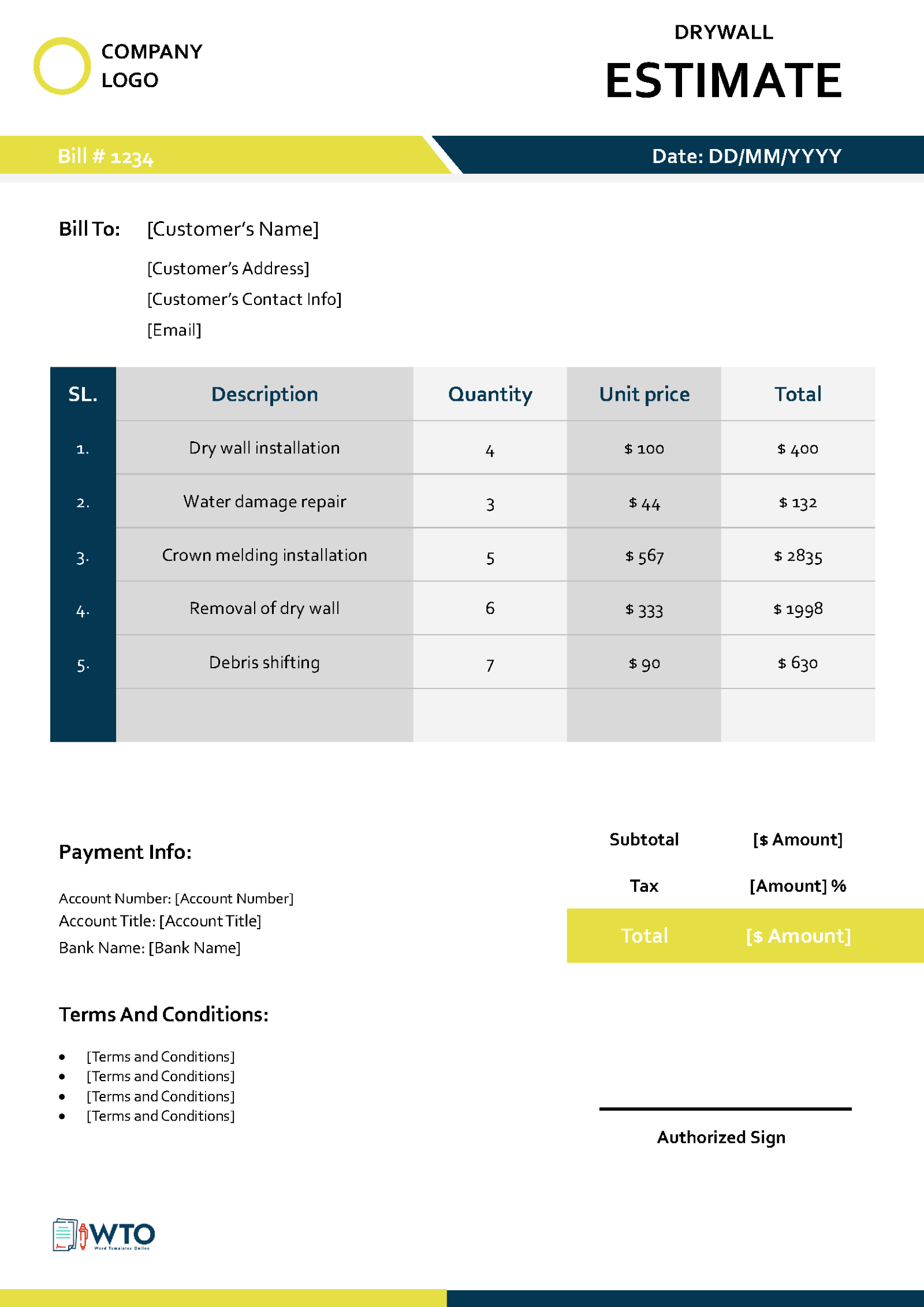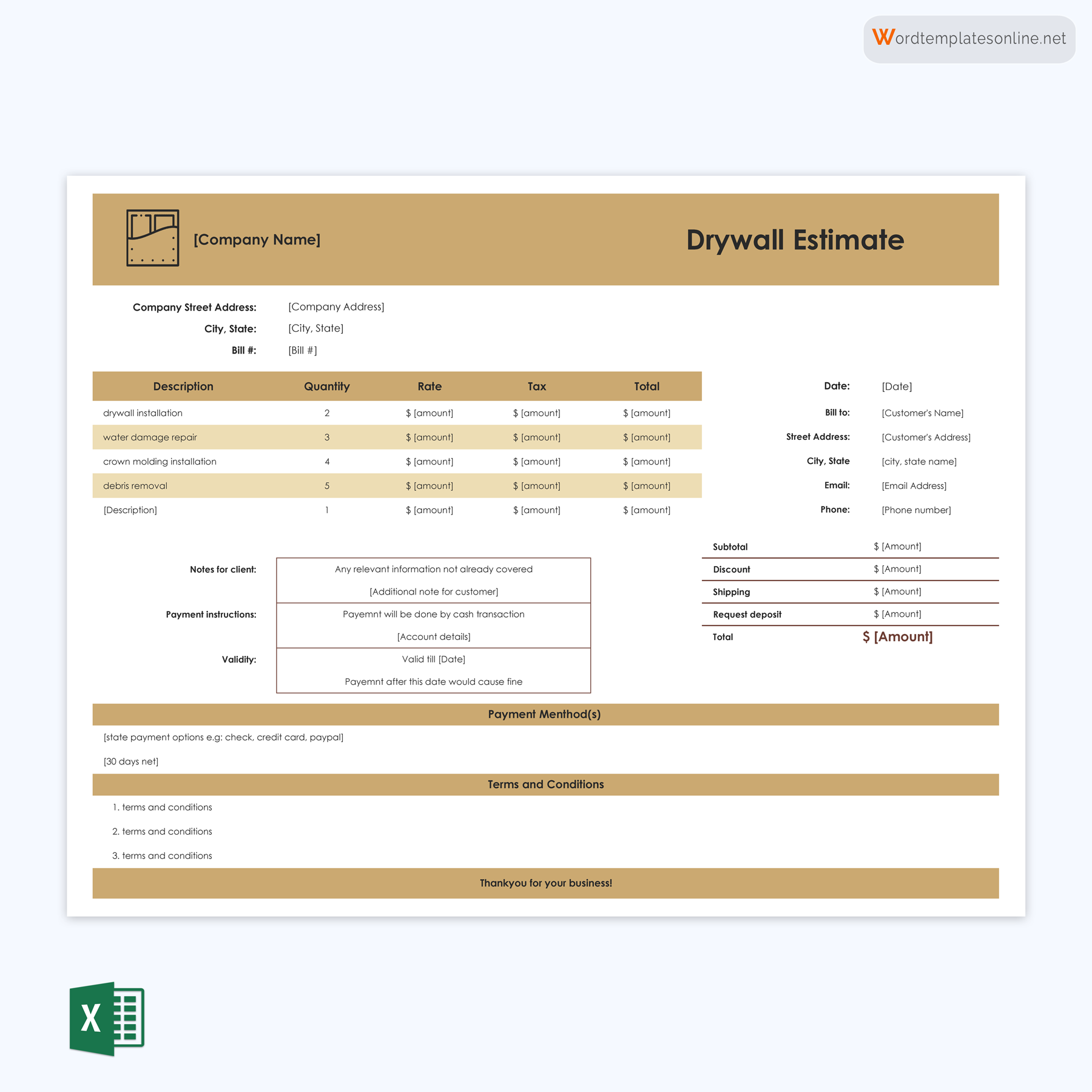A drywall estimate template is a predesigned document used to approximate the cost of a drywall installation or repair.
It entails entries for project identification, materials, labor markup, profit calculations, and additional costs such as permit and disposal fees. This way, the template guides contractors and construction companies on what aspects of the project to consider when estimating it. It is reusable and can thus be used for multiple projects, guaranteeing consistency and transparency in estimation exercises. Each section of the template helps a contractor systematically break down the project requirements. This way, they are able to create an itemized list of costs, thus promoting transparency and effective communication with clients.
A free template for estimating drywall installation and repair costs can assist you in quickly crafting an estimation framework for a project. This way, you do not have to create one from scratch for every project. It can also be customized to incorporate expenses and considerations specific to the project in question. Lastly, it provides a standardized framework that can be utilized consistently to promote uniformity in the estimation process of different projects.
This article looks into the different components of an Excel template meant to guide you on the information you ought to provide in a comprehensive estimate for drywall projects. It also discusses the different types of templates and tips for utilizing them effectively.
What to Include in a Template for Drywall Estimate
The template has placeholders for the fundamental information required to estimate the cost of the project. However, these considerations can vary from project to project. So, it is always advisable to review the template and determine which adjustments are needed.
Below are the elements of the templates and steps on how to fill them appropriately:
Project details
Start by filling in your details, project details, and client information. This information identifies the project and which parties are involved. Ensure to include your and the client’s company name, address, and contact information. Also, specify the date, reference number of the document, and project name. This information is needed for tracking and reference purposes.
Measure square footage
In the next section of the template, specify the square footage of the areas that need the drywall. You will have to measure this area for each room. You can use square feet as the units or modify them to the applicable units of the specific region. The total square footage will be used to calculate the quantity of materials needed for the entire project.
Materials
In this section, include all the materials specific to the project.
Drywall sheets
Use the specified space in this section of the template to record the estimated number of drywall sheets for the square footage determined earlier. Also, state the required sheet size (commonly 4’ by 8’ or 4’ by 12’). You can incorporate a calculation area that uses the square footage and sheet size to determine the number of sheets needed. It is advisable to factor in additional sheets to the calculated number of sheets to account for wastage and potentially damaged pieces during installation. Then, you can calculate the total costs of the needed sheets.
Drywall tape, mud, and screws
In the next section, record the estimated number of screws, tape, and mud needed for the project. The number of screws needed depends on the spacing requirements of a secure installation. Drywall mud is used to seal gaps and provide a smooth finish. Drywall tape is used to cover seams between sheets.
You can modify the template to automatically calculate the total amount of screws, mud, and tape needed for the drywall sheets. The amount of screws is determined by multiplying the total number of sheets by the number of screws needed. The amount of tape is determined by multiplying the total number of sheets by a standard factor of 12. The amount of mud needed is calculated by multiplying the total number of sheets with a factor of 0.053.
Estimate corner beads
Next, record the estimated amount of corner beads needed for the project. You should enlist the different types of corner beads as well as the required amount for each.
Material cost estimation
The next section of the template prompts you to estimate the cost of different resources to be utilized in the project. The template has entries for the description of the item, quantity, rate, and cost of each item. Tangible items are typically charged per unit price, while labor is billed on a rate such as per hour or day.
Labor/hours taken
Then, use the next entry to record the estimated time taken to complete the different tasks up until the completion of the project. This time is used to estimate the cost of labor. This breakdown can also help in developing the project schedule.
Mark-up and profit calculations
You should then define the markup percentage or profit margin you want to apply to the project costs. First, determine the percentage and apply it to the cost of labor and materials. Then, declare the markup or profit amount.
Other costs
Lastly, input any additional expenses associated with the project that must be communicated to the client. These costs may be incurred due to factors such as existing building codes, equipment delivery, type of property, etc. Examples of such costs include project supervision, sandpaper, equipment delivery, paint (if applicable), cost of clearing up the site after the project, transportation to and from the work site, permit fees, insurance, supervision, etc. These costs should be added to determine the total cost of the project.
You can use our free and easy-to-use template to estimate the costs of drywall projects. The template is in Excel format and is designed with certain functionalities, such as addition and multiplication, to simplify the process. Additionally, you can reference samples to understand further how to estimate project costs accurately.
Drywall Estimate Templates
You can use our free and easy-to-use template to estimate the costs of drywall projects. The template is in Excel format and is designed with certain functionalities, such as addition and multiplication, to simplify the process. Additionally, you can reference samples to understand further how to estimate project costs accurately.


Tips for Tailoring the Template to Suit Your Specific Project Requirements
Customization is a fundamental aspect of the template as it offers the flexibility of creating variations of documents that suit different projects. So, it is imperative to learn how to personalize the template effectively.
Below are tips you can adopt in this exercise:
Add or modify sections as needed
You can add new sections or remove and modify existing sections to make the template more suitable for your needs or preferences. This way, you can include unique or specialized considerations to the template to ensure the associated costs are never forgotten.
Incorporate company branding and contact information
Incorporating branding elements can make the template look more professional and increase its effectiveness as it becomes visually engaging. So, you can add a logo with a unique & professional design and modify aspects such as color and font. Also, consider adding your company details, such as name, address, contact information, and email address.
Consider regional factors and pricing
Modify the template to factor in local dynamics such as material costs, labor rates, and specific drywall regulations. Research and update the template with accurate and up-to-date pricing information specific to your geographical area. This produces a template that aligns with the current market conditions.
Review and update the template regularly
Continuously review and update the template to ensure it aligns with the changes in costs, technology advancements, and industry standards. This can be done periodically at your preferred intervals. This way, the template remains relevant and reliable in estimating drywall costs accurately.
Types of Drywall Estimate Template
There are variations of the template for estimating drywall project costs. Each variation is oriented towards a specific category of drywall project.
The common variations include:
Drywall installation estimate template
Such a template is predesigned to suit drywall installation projects. It will typically prompt users to input project details such as site square footage, number of drywall sheets, drywall mud, tape, screws, labor, markup calculations, and other costs.
Drywall repairing estimate template
This template is meant for drywall projects where the contractor is repairing damaged surfaces. Typically, it has entries for documenting the extent of damage on the surface and materials needed for repair. This template may have sections for assessing additional project requirements such as primer needed, texture matching, and specialized repair techniques needed for the particular repairs.
Drywall finishing estimate template
This type of template is used to estimate the finishing requirements of a drywall project. Therefore, it will have fields to outline mudding, tapping, and finishing, such as sanding, texture application, etc., requirements. It also prompts contractors to estimate labor costs and mark-up and profit calculations.
Drywall Estimate Template Vs. Drywall Quote Template
A drywall estimate template is used to approximate the materials, labor, and costs associated with a drywall project. It provides a framework for determining accurate estimates of project requirements before the contractor and the client agree to work together. The template initiates negotiations as the client can understand how much the projected costs will be and why.
Contrary, a drywall quote template provides the official and exact cost and terms of the project. Such a template will have a section to document material and labor costs, payment terms, project timelines, and other costs. The quote serves as a formal request to undertake the project, and once accepted by the client, it becomes a binding document.
Conclusion
To conclude, you should consider using a template whenever you are estimating the costs of a drywall project. It will guide you on what considerations you should prioritize. Understand that you can customize it to incorporate your needs and preferences.
Estimating drywall project costs is a preceding step toward preparing an accurate and persuasive quote. A free template greatly streamlines this process, as you will not always have to start your estimations from scratch. Therefore, you will be able to estimate drywall projects consistently and secure more work.









